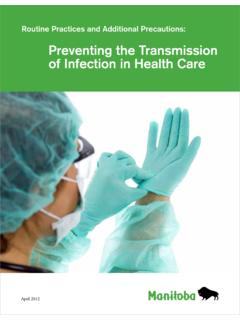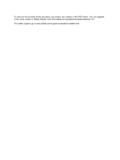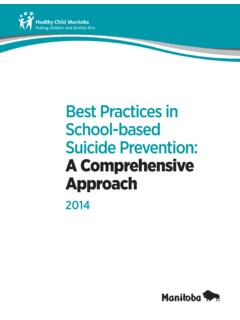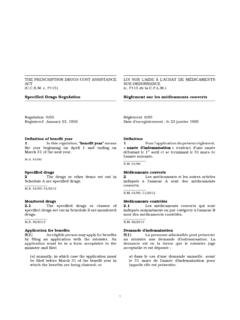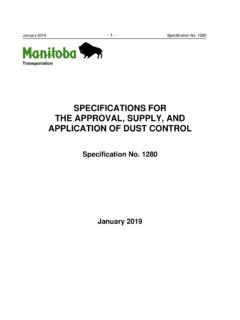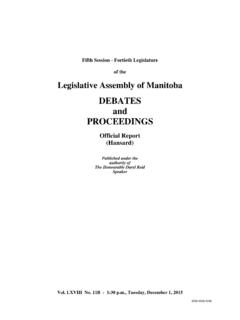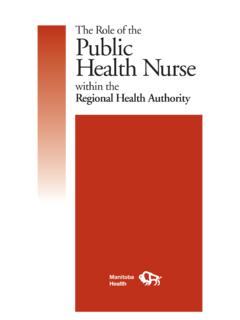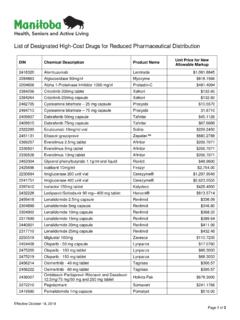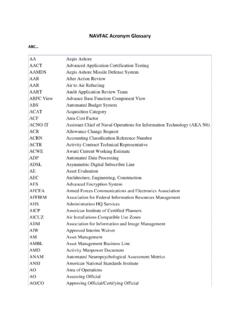Transcription of Examples of Commonly Used Security Safeguards
1 Examples of Commonly used Security Safeguards Administrative Safeguards Access to personal health information and access to any place or system where personal health information is kept must be restricted to individuals who are authorized to use, modify, transform, disclose, dispose or destroy personal health information to perform their assigned duties. Employees and other information users must be authorized to access, maintain, change, use or distribute information. Authorization for each information user should be based on the need to know of that individual.
2 Security checks may need to be employed to ensure that individuals in key employee positions are screened. This includes background checks and taking oaths of confidentiality, where necessary. Screening of personnel should be done on a regular basis, and criminal record checks may be appropriate and required in some cases. For example , health care providers like hospitals and nursing homes should require every successful applicant for employment and every new volunteer to provide a criminal records check. All systems programmers, network/LAN technical staff, ID administrators, file and mailroom staff that have privileged access to the work environment and have to be trusted.
3 Information access privileges should be reviewed, modified or revoked as necessary when: an employee is transferred by appointment, assignment or secondment; an employee commences an extended period of absence, including maternity, medical, military or community service; access privileges have not been exercised for a period of time; or the employment or contract of the individual has been terminated. Upon termination: the individual should be debriefed with respect to ongoing responsibilities for the confidentiality of Trustee information; access privileges ( system passwords, user ID s, combinations, etc.)
4 To systems, restricted access zones, and IT facilities should be revoked; and all Security related items (badges, keys, documents, etc.) issued to the individual should be retrieved. To ensure that parties accessing information are who they say they are, the identity of any individual who accesses, uses, modifies, transforms, discloses or disposes of health information must be verified and authenticated prior to access to information being granted. The most common form of this safeguard in an electronic environment is the use of passwords. However, it could also include requiring proof of identification using tokens, biometrics, challenge/response scenarios, one-time passwords, digital signatures and certification authorities.
5 Authentication passwords or codes must be: generated, controlled and distributed in a manner which maintains the confidentiality and integrity of the code or password; known only to the user of the identifier; either pseudo-random in nature or verified by an automated process designed to counter triviality and repetition; at least 7 characters in length; one-way encrypted for storage in the computer system subject to a history check to preclude reuse; prompted for manual user entry when using automatic or scripted log-on processes; changed at least every 90 days; and a mixture of characters, both upper and lower case, numbers, punctuation and special symbols.
6 Records should be kept identifying all instances of access, use, modification, transformation, disclosure or disposal of individually identifying diagnostic, treatment and care information. Records must be kept of all instances of unauthorized access, use, change, deletion/disposition or disclosure of personal health information. Procedures, policies and practices must be implemented to restore, replace or re-create personal health information that has been damaged, lost or destroyed either accidentally or deliberately. Policies, procedures, practices and other Safeguards must be implemented to minimize the risk from unauthorized access to, or unauthorized use, modification, transformation, disclosure, disposal or destruction of personal health information, and also to ensure accuracy and completeness of personal health information.
7 Each Trustee must have or adopt policies and procedures that facilitate the administration of PHIA and the Regulation. Policies and procedures of Trustees should cover all aspects of administering the act but are particularly important in the area of ensuring the confidentiality and Security of personal health information in their custody or under their control and the privacy of the individuals who are the subjects of that personal health information. The policies and practices suggested in this document could form the basis of what is adopted by a Trustee. Larger Trustee organizations must have substantial policies and procedures in place covering the collection, use, disclosure, Security , retention and destruction of personal health information.
8 These should be periodically reviewed and adjusted as needed to comply with any changes applicable laws, such as PHIA. Regulated health professionals may be guided by standards for health records or for the disclosure of personal health information published by their regulatory bodies. For example , By-law #11 Standards of Practice of Medicine of the College of Physicians and Surgeons of Manitoba contains, among other things, requirements for their membership in respect of patient records and privacy and confidentiality. The policies and procedures should be in writing, current, and available to all staff.
9 Policies, procedures and penalties for non-compliance should also be outlined in contracts for service providers. Physical Safeguards In addition to restrictions on who can access personal health information, access to the facility, offices, information retrieval equipment and systems and information stores must be controlled to ensure that access is granted only to individuals with authorization for such access. These controls relate to mechanisms in a computer operating system , hardware unit, software package, file room or mailroom. This is typically a password for systems access but may include card locks and physical Security access systems such as keys, digital card keys and cipher lock barriers.
10 Physical Security Safeguards to maintain access control can range from anti-theft systems such as bolting equipment to the floor in secure rooms, locked desks and cabinets. Smaller Trustees with little personal health information in electronic form should concentrate on physical Security measures (locked rooms or cabinets, adequate access controls for employees and the public and sound disposition measures for the information). Larger Trustees with sensitive personal health information in a variety of forms and formats will have to take a wider range of Security measures based upon the threat and risk analysis conducted.
